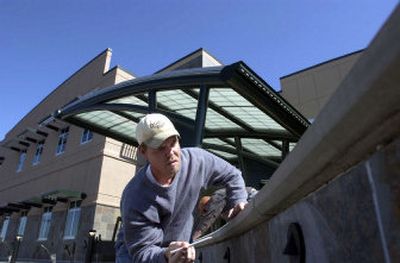New building is healthy growth for Panhandle Health District

It’s not like residents whizzing north on Hayden’s Atlas Road can miss it. The sleek new slate-and-concrete headquarters of the Panhandle Health District has risen in less than a year amid a sea of houses on Coeur d’Alene’s north edge.
For employees set to move into the two-story, 46,000-square-foot building next week, the end of construction will mean the start of a new era of comfort and collaboration. The $5.2 million building will bring together about 100 employees scattered in five sites from strip malls to rented offices, said District Director Jeanne Bock.
Even more important, the center will transform access for some 125 local clients a day who seek public health services ranging from flu shots and family planning help to sewer permits.
“It’s really an opportunity to have a new beginning,” Bock said Wednesday, leading visitors on an early tour.
When the new building opens on May 22, clients will discover user-friendly access to clinical services, environmental protection and the Women, Infant and Children program (WIC).
Amenities will include a sound-proof play area for small children, conference rooms available for public use and the possibility of creating a standalone command center in the event of terrorism or other disaster.
As workers glued floor tiles and installed cubicles, Bock described a dream that’s been 16 years in the making.
That’s how long staff members of the health district that serves Idaho’s five northern counties have been pining and planning for new quarters. They long ago outgrew the space at 2195 Ironwood Court, Bock said.
“WIC program and Health Promotions have been 12 years in the basement,” she said.
But budget constraints prohibited any movement. The health district is a special purpose district, not a state agency, Bock explained. Only about 12 percent of its annual $11 million budget comes from state sources, and none of that may be used for construction, she added.
So organizers had to come up with creative solutions for financing the project at every stage. First, there was an arrangement to share 15 acres of former farmland. A cooperative agreement with the City of Hayden, the Coeur d’Alene School District and the Panhandle Health District yielded enough space for a new elementary school and the new public health building.
“We had talked about our common interests and our common goals,” Bock said.
Construction costs were paid for through a combination of sources. Most of it has come from a $4.3 million loan through Idaho Health Facilities financing, Bock said. Another $2.1 million came from sale of the existing building to the Kootenai Health District, whose board members included the property in the local hospital’s 20-year master plan.
More support will be needed in the future, noted Bock, who has helped create the Panhandle Public Health Foundation. The foundation hopes to secure funding to ensure that public health services don’t come and go at the whim of public budgets, Bock said.
For $1 million, a benefactor can secure title to the yet-unnamed health center building. For $25,000, someone can name the first staff lunch room. A contribution of $1,000 will pay for a space on the foyer donor wall, while $200 is enough for an engraved block in the courtyard garden.
But the foundation kick-off will have to wait until October, when Bock and other organizers are planning a formal ribbon-cutting and open house.
In the meantime, she and other employees are reveling in what they haven’t had: space. The new building, designed by local firm Architects West, includes a flexible floor plan that can be adjusted as need decrees.
“Considering that we have so many functions in our building, it’s been designed for maximum functionality,” said Mark Anderson, one of the project managers.
Organizers figure the new building will be able to absorb about 20 percent more staff and an equal increase in clients. There’s room to expand, too, if necessary, said Bock, who expects the new building to last several decades in a rapidly changing field.
“We purposely kept as much open as we could because we don’t know what public health will be in 30 years,” she said.